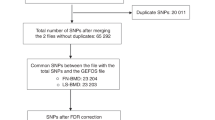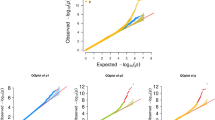Abstract
Osteoporosis is a highly heritable common bone disease leading to fractures that severely impair the life quality of patients. Wrist fractures caused by osteoporosis are largely due to the scarcity of wrist bone mass. Here we report the results of a genome-wide association study (GWAS) of wrist bone mineral density (BMD). We examined ∼500000 SNP markers in 1000 unrelated homogeneous Caucasian subjects and found a novel allelic association with wrist BMD at rs11023787 in the SOX6 (SRY (sex determining region Y)-box 6) gene (P=9.00×10−5). Subjects carrying the C allele of rs11023787 in SOX6 had significantly higher mean wrist BMD values than those with the T allele (0.485:0.462 g cm−2 for C allele vs. T allele carriers). For validation, we performed SOX6 association for BMD in an independent Chinese sample and found that SNP rs11023787 was significantly associated with wrist BMD in the Chinese sample (P=6.41×10−3). Meta-analyses of the GWAS scan and the replication studies yielded P-values of 5.20×10−6 for rs11023787. Results of this study, together with the functional relevance of SOX6 in cartilage formation, support the SOX6 gene as an important gene for BMD variation.
Similar content being viewed by others
References
Ray N F, Chan J K, Thamer M, et al. Medical expenditures for the treatment of osteoporotic fractures in the United States in 1995: report from the National Osteoporosis Foundation. J Bone Miner Res, 1997, 12: 24–35 1:STN:280:DyaK2szot1Oguw%3D%3D, 10.1359/jbmr.1997.12.1.24, 9240722
Public Health Service Office of the Surgeon General Public Health Service Office of the Surgeon General. 2004
Ioannidis G, Gordon M, Adachi J D. Quality of life in osteoporosis. Nurs Clin North Am, 2001, 36: 481–489 1:STN:280:DC%2BD3MvptFSgtA%3D%3D, 11532662
Schousboe J T, Fink H A, Taylor B C, et al. Association between self-reported prior wrist fractures and risk of subsequent hip and radiographic vertebral fractures in older women: a prospective study. J Bone Miner Res, 2005, 20: 100–106 10.1359/JBMR.041025, 15619675
Niu T, Rosen C J. The insulin-like growth factor-I gene and osteoporosis: a critical appraisal. Gene, 2005, 361: 38–56 1:CAS:528:DC%2BD2MXhtFGhsbjJ, 10.1016/j.gene.2005.07.016, 16183214
Deng H W, Xu F H, Huang Q Y, et al. A whole-genome linkage scan suggests several genomic regions potentially containing quantitative trait loci for osteoporosis. J Clin Endocrinol Metab, 2002, 87: 5151–5159 1:CAS:528:DC%2BD38Xos1ynt7s%3D, 10.1210/jc.2002-020474, 12414886
Shen H, Zhang Y Y, Long J R, et al. A genome-wide linkage scan for bone mineral density in an extended sample: evidence for linkage on 11q23 and Xq27. J Med Genet, 2004, 41: 743–751 1:CAS:528:DC%2BD2cXpsl2gsbk%3D, 10.1136/jmg.2004.020396, 15466007
Ralston S H, Galwey N, MacKay I, et al. Loci for regulation of bone mineral density in men and women identified by genome wide linkage scan: the FAMOS study. Hum Mol Genet, 2005, 14: 943–951 1:CAS:528:DC%2BD2MXis1yjt7Y%3D, 10.1093/hmg/ddi088, 15746152
Peacock M, Koller D L, Fishburn T, et al. Sex-specific and non-sex-specific quantitative trait loci contribute to normal variation in bone mineral density in men. J Clin Endocrinol Metab, 2005, 90: 3060–3066 1:CAS:528:DC%2BD2MXkt1Wgurg%3D, 10.1210/jc.2004-2143, 15741260
Shen H, Liu Y, Liu P, et al. Nonreplication in genetic studies of complex diseases-lessons learned from studies of osteoporosis and tentative remedies. J Bone Miner Res, 2005, 20: 365–376 1:CAS:528:DC%2BD2MXis1Kntbs%3D, 10.1359/JBMR.041129, 15746981
Thakkinstian A, D’Este C, Eisman J, et al. Meta-analysis of molecular association studies: vitamin D receptor gene polymorphisms and BMD as a case study. J Bone Miner Res, 2004, 19: 419–428 1:CAS:528:DC%2BD2cXisFCrsb0%3D, 10.1359/JBMR.0301265, 15040830
Macdonald H M, McGuigan F E, Stewart A, et al. Large-scale population-based study shows no evidence of association between common polymorphism of the VDR gene and BMD in British women. J Bone Miner Res, 2006, 21: 151–162 1:CAS:528:DC%2BD28Xpt1SmsA%3D%3D, 10.1359/JBMR.050906, 16355284
Ralston S H, Uitterlinden A G, Brandi M L, et al. Large-scale evidence for the effect of the COLIA1 Sp1 polymorphism on osteoporosis outcomes: the GENOMOS study. PLoS, 2006, 14: 943–951
Hirschhorn J N, Daly M J. Genome-wide association studies for common diseases and complex traits. Nat Rev Genet, 2005, 6: 95–108 1:CAS:528:DC%2BD2MXhtFyjsr8%3D, 10.1038/nrg1521, 15716906
Ahn S J, Costa J, Emanuel J R. PicoGreen quantitation of DNA: effective evaluation of samples pre- or post-PCR. Nucleic Acids Res, 1996, 24: 2623–2625 1:CAS:528:DyaK28XksVyjt7o%3D, 10.1093/nar/24.13.2623, 8692708
Singer V L, Jones L J, Yue S T, et al. Characterization of PicoGreen reagent and development of a fluorescence-based solution assay for double-stranded DNA quantitation. Anal Biochem, 1997, 249: 228–238 1:CAS:528:DyaK2sXktF2rsbo%3D, 10.1006/abio.1997.2177, 9212875
Di X, Matsuzaki H, Webster T A, et al. Dynamic model based algorithms for screening and genotyping over 100 K SNPs on oligonucleotide microarrays. Bioinformatics, 2005, 21: 1958–1963 1:CAS:528:DC%2BD2MXjsl2nsLc%3D, 10.1093/bioinformatics/bti275, 15657097
Rabbee N, Speed T P. A genotype calling algorithm for affymetrix SNP arrays. Bioinformatics, 2005, 22: 7–12 10.1093/bioinformatics/bti741, 16267090
Zaykin D V, Westfall P H, Young S S, et al. Testing association of statistically inferred haplotypes with discrete and continuous traits in samples of unrelated individuals. Hum Hered, 2002, 53: 79–91 10.1159/000057986, 12037407
Weir B. Genetic Data Analysis III. Sunderland: Sinauer Associates, 2007
Price A L, Patterson N J, Plenge R M, et al. Principal components analysis corrects for stratification in genome-wide association studies. Nat Genet, 2006, 38: 904–909 1:CAS:528:DC%2BD28XnsVCgsrg%3D, 10.1038/ng1847, 16862161
Barrett J C, Fry B, Maller J, et al. Haploview: analysis and visualization of LD and haplotype maps. Bioinformatics, 2005, 21: 263–265 1:CAS:528:DC%2BD2MXkt1WitQ%3D%3D, 10.1093/bioinformatics/bth457, 15297300
Yuan H Y, Chiou J J, Tseng W H, et al. FASTSNP: an always up-to-date and extendable service for SNP function analysis and prioritization. Nucleic Acids Res, 2006, 34: W635–W641 1:CAS:528:DC%2BD28Xps1yhs7c%3D, 10.1093/nar/gkl236, 16845089
Whitlock M C. Combining probability from independent tests: the weighted Z-method is superior to Fisher’s approach. J Evol Biol, 2005, 18: 1368–1373 1:STN:280:DC%2BD2Mvmsl2hug%3D%3D, 10.1111/j.1420-9101.2005.00917.x, 16135132
Loannidis J P, Ng M Y, Sham P C, et al. Meta-analysis of genome-wide scans provides evidence for sex- and site-specific regulation of bone mass. J Bone Miner Res, 2007, 22: 173–83 10.1359/jbmr.060806
Vidal C, Galea R, Brincat M, et al. Linkage to chromosome 11p12 in two Maltese families with a highly penetrant form of osteoporosis. Eur J Hum Genet, 2007, 15: 800–809 1:CAS:528:DC%2BD2sXmslSrsbk%3D, 10.1038/sj.ejhg.5201814, 17377523
Pevny L H, Lovell-Badge R. Sox genes find their feet. Curr Opin Genet Dev, 1997, 7: 338–344 1:CAS:528:DyaK2sXksVyntr8%3D, 10.1016/S0959-437X(97)80147-5, 9229109
Lefebvre V, Li P, de C B. A new long form of Sox5 (L-Sox5), Sox6 and Sox9 are coexpressed in chondrogenesis and cooperatively activate the type II collagen gene. EMBO J, 1998, 17: 5718–5733 1:CAS:528:DyaK1cXmvVyjsLs%3D, 10.1093/emboj/17.19.5718, 9755172
De C B, Lefebvre V, Behringer R R, et al. Transcriptional mechanisms of chondrocyte differentiation. Matrix Biol, 2000, 19: 389–394 10.1016/S0945-053X(00)00094-9
Lefebvre V, Behringer R R, {fnde} C B. L-Sox5, Sox6 and Sox9 control essential steps of the chondrocyte differentiation pathway. Osteoarthritis Cartilage, 2001, 9: S69–S75 10.1053/joca.2001.0447, 11680692
Uusitalo H, Hiltunen A, Ahonen M, et al. Accelerated up-regulation of L-Sox5, Sox6, and Sox9 by BMP-2 gene transfer during murine fracture healing. J Bone Miner Res, 2001, 16: 1837–1845 1:CAS:528:DC%2BD3MXnsVKqtL8%3D, 10.1359/jbmr.2001.16.10.1837, 11585348
Smits P, Li P, Mandel J, et al. The transcription factors L-Sox5 and Sox6 are essential for cartilage formation. Dev Cell, 2001, 1: 277–290 1:CAS:528:DC%2BD3MXntVGrsLs%3D, 10.1016/S1534-5807(01)00003-X, 11702786
Woods A, Wang G, Dupuis H, et al. Rac1 signaling stimulates N-cadherin expression, mesenchymal condensation and chondrogenesis. J Biol Chem, 2007, 282: 23500–23508 1:CAS:528:DC%2BD2sXosVyrtrY%3D, 10.1074/jbc.M700680200, 17573353
Author information
Authors and Affiliations
Corresponding author
Rights and permissions
About this article
Cite this article
Tan, L., Liu, R., Lei, S. et al. A genome-wide association analysis implicates SOX6 as a candidate gene for wrist bone mass. Sci. China Life Sci. 53, 1065–1072 (2010). https://doi.org/10.1007/s11427-010-4056-7
Received:
Accepted:
Published:
Issue Date:
DOI: https://doi.org/10.1007/s11427-010-4056-7




